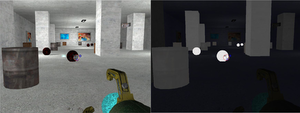Information
- Publication Type: Journal Paper (without talk)
- Workgroup(s)/Project(s):
- Date: October 2010
- ISSN: 1544-3558
- Journal: ACM Transactions on Applied Perception
- Number: 1
- Volume: 8
- Pages: 4:1 – 4:30
- Keywords: gaze predictor, video games, virtual environments, eye-tracking, gaze analysis
Abstract
Gaze analysis and prediction in interactive virtual environments, such as games, is a challenging topic since the 3D perspective and variations of the viewpoint as well as the current task introduce many variables that affect the distribution of gaze. In this article, we present a novel pipeline to study eye-tracking data acquired from interactive 3D applications. The result of the pipeline is an importance map which scores the amount of gaze spent on each object. This importance map is then used as a heuristic to predict a user’s visual attention according to the object properties present at runtime. The novelty of this approach is that the analysis is performed in object space and the importance map is defined in the feature space of high-level properties. High-level properties are used to encode task relevance and other attributes, such as eccentricity, which may have an impact on gaze behavior.The pipeline has been tested with an exemplary study on a first-person shooter game. In particular, a protocol is presented describing the data acquisition procedure, the learning of different importance maps from the data, and finally an evaluation of the performance of the derived gaze predictors. A metric measuring the degree of correlation between attention predicted by the importance map and the actual gaze yielded clearly positive results. The correlation becomes particularly strong when the player is attentive to an in-game task.
Additional Files and Images
Weblinks
BibTeX
@article{bernhard-2010-gph,
title = "An Empirical Pipeline to Derive Gaze Prediction Heuristics
for 3D Action Games",
author = "Matthias Bernhard and Efstathios Stavrakis and Michael
Wimmer",
year = "2010",
abstract = "Gaze analysis and prediction in interactive virtual
environments, such as games, is a challenging topic since
the 3D perspective and variations of the viewpoint as well
as the current task introduce many variables that affect the
distribution of gaze. In this article, we present a novel
pipeline to study eye-tracking data acquired from
interactive 3D applications. The result of the pipeline is
an importance map which scores the amount of gaze spent on
each object. This importance map is then used as a heuristic
to predict a user’s visual attention according to the
object properties present at runtime. The novelty of this
approach is that the analysis is performed in object space
and the importance map is defined in the feature space of
high-level properties. High-level properties are used to
encode task relevance and other attributes, such as
eccentricity, which may have an impact on gaze behavior.
The pipeline has been tested with an exemplary study on a
first-person shooter game. In particular, a protocol is
presented describing the data acquisition procedure, the
learning of different importance maps from the data, and
finally an evaluation of the performance of the derived gaze
predictors. A metric measuring the degree of correlation
between attention predicted by the importance map and the
actual gaze yielded clearly positive results. The
correlation becomes particularly strong when the player is
attentive to an in-game task.",
month = oct,
issn = "1544-3558",
journal = "ACM Transactions on Applied Perception",
number = "1",
volume = "8",
pages = "4:1--4:30",
keywords = "gaze predictor, video games, virtual environments,
eye-tracking, gaze analysis",
URL = "https://www.cg.tuwien.ac.at/research/publications/2010/bernhard-2010-gph/",
}



